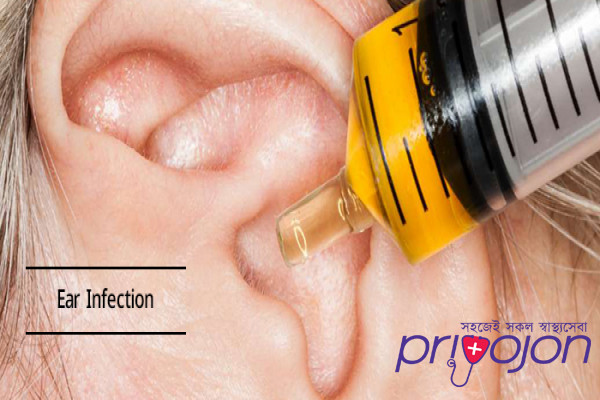Shared on 27-02-2020
Facts About Ear Infections and Other Ear Issues
Facts About Ear Infections and Other Ear Issues

Ear infections (medically known as otitis media) are the most common reason parents bring children to see a health care provider. For an ear infection, you may choose to see a provider who specializes in otology. That’s the specialty that focuses on the external, middle and inner ear.
About three out of four children will have at least one ear infection by their third birthday. More than a million ear tube surgeries are performed on children every year. It’s the most common childhood surgery performed with anesthesia.
Teens and adults can get ear infections, too, but they’re less common.
When a child has an ear infection, you may notice:
- Crying more than usual because of discomfort.
- Tugging at ears.
Hearing problems. If you’ve been around kids, you likely know a child who has had an ear infection.
- Balance difficulties.
- Trouble sleeping.
- Fluid draining from the ears.
What Happens With an Ear Infection?
An ear infection is an inflammation of the middle ear. Bacteria cause most ear infections. Ear infections can also be viral.
During an ear infection, fluids typically build up behind the eardrum. That can cause the symptoms we mentioned.
There are three types of ear infection:
Acute otitis media — with this common ear infection, parts of the middle ear become infected and swollen. Fluid becomes trapped behind the eardrum, causing an earache. Your child might also have a fever.
Otitis media with effusion — after an ear infection has run its course, fluid sometimes stays trapped behind the eardrum. A child with this infection may have no symptoms, but your health care provider will be able to see the fluid behind the eardrum using a special instrument. A decrease in hearing and a change in speech may be present.
Chronic otitis media with effusion — fluid remains in the middle ear for a long time or returns over and over again, even without an infection. This condition makes it harder for children to fight new infections. It can also affect their hearing.
What Are Treatments for Ear Infections?
Ear infections caused by bacteria can be treated by antibiotics. Recurring use of antibiotics may lead to resilient bacteria.
Infections caused by a virus usually go away on their own.
If the ear infection or middle ear fluid doesn’t go away or comes back often, an otolaryngologist – an ear, nose and throat doctor, may suggest ear tubes. They’re also called tympanostomy tubes, myringotomy tubes, ventilation tubes or pressure equalization tubes.
These are small cylinders inserted through the eardrum. They allow air into the middle ear. This helps relieve inflammation and drain fluids. The tubes make ear infections less likely and easier to treat without oral antibiotics.
The tubes can:
- Reduce the risk of future ear infections.
- Help drain middle ear fluid and restore hearing.
- Reduce speech problems caused by hearing loss.
- Improve balance.
Antibiotic drops are also effective in treating ear infections.
What About Other Ear Problems?
The eustachian tube is the narrow tube that links the back of your nose to the middle ear. The eustachian tube is normally closed, but it opens when you chew, swallow or yawn. It helps balance air pressure in your ear.
The eustachian tube ventilates the middle ear. It helps drain secretions away from the middle ear and protects the middle ear from sources of disease.
What’s called eustachian tube dysfunction (ETD) happens when the eustachian tube doesn’t open and close normally. This can happen if you have a cold or a nose, sinus or throat infection.
ETD is more common in children because their tubes are shorter and straighter. This makes it easier for germs to get to the middle ear and for fluid to get trapped there.
For adults, smoking and being obese increase the risk for ETD.
The symptoms of ETD are similar to those of an ear infection. They include:
- Muffled hearing.
- Pain in the ear.
- A feeling of fullness in the ear.
- Ringing in the ear.
- Dizziness.
- Inability of balance pressure in the ear.
What’s the Treatment for Eustachian Tube Dysfunction?
When the eustachian tube becomes blocked, it can possibly be opened using a relatively new approach for patients who fit the criteria. With the new system, a small catheter is inserted into the patient’s nose. The surgeon then carefully guides the catheter into the eustachian tube.
At the tip of the catheter is a small balloon that can be inflated in the eustachian tube. Once inflated, the balloon opens a pathway through the eustachian tube. The expanded opening allows mucus and air to flow through. The opening helps restore proper eustachian tube function.
At the end of the procedure, the balloon is deflated and removed along with the catheter.
In other adult patients, tubes can be placed in the office using local anesthesia. Long-lasting tubes are available.
Ear infections (medically known as otitis media) are the most common reason parents bring children to see a health care provider. For an ear infection, you may choose to see a provider who specializes in otology. That’s the specialty that focuses on the external, middle and inner ear.
About three out of four children will have at least one ear infection by their third birthday. More than a million ear tube surgeries are performed on children every year. It’s the most common childhood surgery performed with anesthesia.
Teens and adults can get ear infections, too, but they’re less common.
When a child has an ear infection, you may notice:
- Crying more than usual because of discomfort.
- Tugging at ears.
Hearing problems. If you’ve been around kids, you likely know a child who has had an ear infection.
- Balance difficulties.
- Trouble sleeping.
- Fluid draining from the ears.
What Happens With an Ear Infection?
An ear infection is an inflammation of the middle ear. Bacteria cause most ear infections. Ear infections can also be viral.
During an ear infection, fluids typically build up behind the eardrum. That can cause the symptoms we mentioned.
There are three types of ear infection:
Acute otitis media — with this common ear infection, parts of the middle ear become infected and swollen. Fluid becomes trapped behind the eardrum, causing an earache. Your child might also have a fever.
Otitis media with effusion — after an ear infection has run its course, fluid sometimes stays trapped behind the eardrum. A child with this infection may have no symptoms, but your health care provider will be able to see the fluid behind the eardrum using a special instrument. A decrease in hearing and a change in speech may be present.
Chronic otitis media with effusion — fluid remains in the middle ear for a long time or returns over and over again, even without an infection. This condition makes it harder for children to fight new infections. It can also affect their hearing.
What Are Treatments for Ear Infections?
Ear infections caused by bacteria can be treated by antibiotics. Recurring use of antibiotics may lead to resilient bacteria.
Infections caused by a virus usually go away on their own.
If the ear infection or middle ear fluid doesn’t go away or comes back often, an otolaryngologist – an ear, nose and throat doctor, may suggest ear tubes. They’re also called tympanostomy tubes, myringotomy tubes, ventilation tubes or pressure equalization tubes.
These are small cylinders inserted through the eardrum. They allow air into the middle ear. This helps relieve inflammation and drain fluids. The tubes make ear infections less likely and easier to treat without oral antibiotics.
The tubes can:
- Reduce the risk of future ear infections.
- Help drain middle ear fluid and restore hearing.
- Reduce speech problems caused by hearing loss.
- Improve balance.
Antibiotic drops are also effective in treating ear infections.
What About Other Ear Problems?
The eustachian tube is the narrow tube that links the back of your nose to the middle ear. The eustachian tube is normally closed, but it opens when you chew, swallow or yawn. It helps balance air pressure in your ear.
The eustachian tube ventilates the middle ear. It helps drain secretions away from the middle ear and protects the middle ear from sources of disease.
What’s called eustachian tube dysfunction (ETD) happens when the eustachian tube doesn’t open and close normally. This can happen if you have a cold or a nose, sinus or throat infection.
ETD is more common in children because their tubes are shorter and straighter. This makes it easier for germs to get to the middle ear and for fluid to get trapped there.
For adults, smoking and being obese increase the risk for ETD.
The symptoms of ETD are similar to those of an ear infection. They include:
- Muffled hearing.
- Pain in the ear.
- A feeling of fullness in the ear.
- Ringing in the ear.
- Dizziness.
- Inability of balance pressure in the ear.
What’s the Treatment for Eustachian Tube Dysfunction?
When the eustachian tube becomes blocked, it can possibly be opened using a relatively new approach for patients who fit the criteria. With the new system, a small catheter is inserted into the patient’s nose. The surgeon then carefully guides the catheter into the eustachian tube.
At the tip of the catheter is a small balloon that can be inflated in the eustachian tube. Once inflated, the balloon opens a pathway through the eustachian tube. The expanded opening allows mucus and air to flow through. The opening helps restore proper eustachian tube function.
At the end of the procedure, the balloon is deflated and removed along with the catheter.
In other adult patients, tubes can be placed in the office using local anesthesia. Long-lasting tubes are available.
Medically reviewed by
Dr. Rabeya Afroz Shomi
MBBS, FCPS, Dhaka Medical
3 Years of Experience
- Written by the Priyojon Editorial Team
